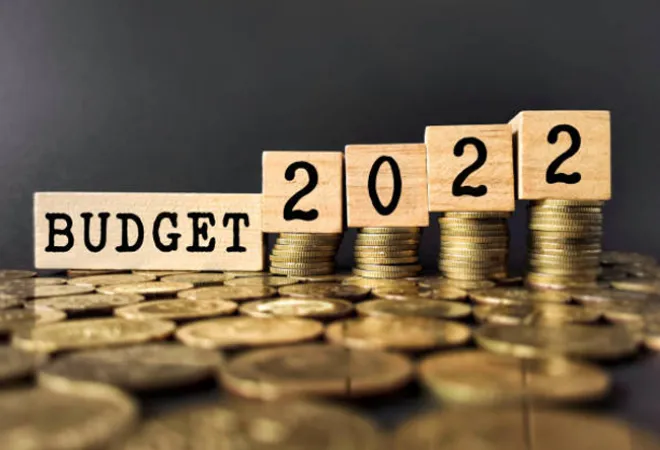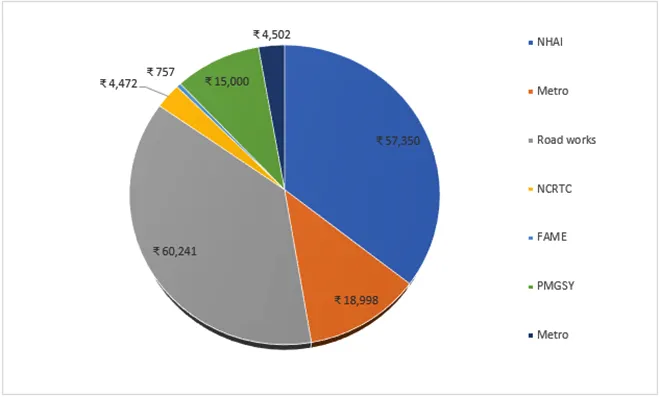-
CENTRES
Progammes & Centres
Location
This year’s budget should prioritse the growth of transport infrastructure rooted in environmental and social sustainability

The transport sector will play an important role in the post-pandemic recovery, both as a facilitator of economic activity and as a direct contributor to GDP and jobs. Thus, there are significant expectations from this year’s budget to set the future priorities for this growing sector.
Traditionally, budget allocation for transport has focused largely on augmenting road infrastructure and other mega projects, such as metros. In the previous budget, planned expenditure on transport-related items accounted for 7 percent of the total expenditure. Of this, 73 percent of the budgeted expenditure was related to road works, with INR 57,350 crores allocated to the National Highway Authority and INR 60,241 crores allocated for other road works. Another 15, 000 crores (9 percent) were allocated to the PM Gram Sadak Yojana (PMGSY) which aims to improve road connectivity to unconnected habitations. The other major allocations were for metro projects (3 percent) and to the FAME scheme for encouraging electric vehicle adoption.
Figure 1: Expenditure on transport in the 2021 Budget (in crore INR)
 Source: Union Budget, 2021
Source: Union Budget, 2021Investment in transport infrastructure is considered a prerequisite for economic growth. However, some restructuring of priorities is desired, to ensure that transport infrastructure growth is aligned with broader environmental and social goals. Highlighted below are some areas within transport which should be prioritised in this year’s budget.
Road accidents continue to be a leading cause of death in the country, claiming a staggering 1.5 lakh lives every year. India has the second-highest road density in the world and the highest number of road accident-related deaths. Despite the startling statistics, the government efforts at improving road safety are still peripheral to other interests. Last year’s budget is a good example, out of the INR 91,823 crore allocated to the Ministry of Road Transport and Highways (MoRTH), only 0.4 percent (INR 379 crore) was allocated for road safety. In contrast, the US Federal Government spends USD 2.7 billion on road safety, which is 6 percent of its total expenditure on highways.
Road accidents continue to be a leading cause of death in the country, claiming a staggering 1.5 lakh lives every year. India has the second-highest road density in the world and the highest number of road accident-related deaths.
This year, the budget allocation for MoRTH is expected to be even higher, around INR 1.5 lakh crores. Once again, the focus will be on expanding the road network under the Bharatmala Project. However, this also provides a great opportunity to increase spending on road safety and send a clear message that this is a priority for the country. This must be done to ensure that growth in the road network does not come at the cost of human lives. To quote the Sundar Committee Report on Road Safety and Traffic Management: “Road traffic injury prevention and mitigation should be given the same attention and scale of resources that are currently being channelled towards other predominant health issues.”
A greater focus from MoRTH towards road safety can go a long way towards the identification and implementation of effective safety measures. Firstly, there is a need to establish a robust nationwide information collection system for road accidents that can be used to easily identify black spots, devise appropriate solutions and track the success of existing interventions. In its 2019 Global Health Estimates, the WHO classified India’s official data on road fatalities as ‘unusable’ or ‘unavailable because of quality issues.’ Further, we must scale up our efforts toward implementing better road safety measures. MoRTH can play a key role through increased funding for research and data analysis as well as direct investment in strategic transport infrastructure and black spot improvement projects. By expanding the road safety allocation, the Centre can also aid cash-strapped states in implementing more road safety initiatives. There is a need to set up a specific funded programme to prioritize this in our development efforts.
Historically, investment in public transport infrastructure has failed to keep up with increased urbanisation. Recently, investments in metro systems have picked up, but the public bus system remains neglected. The Ministry of Home and Urban Affairs (MoHUA) recommends around 30-60 million public buses per 100,000 people, depending on the size of the city. However, only 280,000 buses in India are currently operated by the State Transport Undertakings (STUs) or run under stage carriage permits, translating to less than 20 buses per 100,000 people. To compound the problem, a large part of the fleet is overage, leading to low fuel efficiency and a poor commuter experience. The severe shortage of buses and poor service quality are major reasons behind the recent boom in private vehicle usage and the associated increases in emissions and congestion.
A National Bus Procurement Programme funded by the Central Government can go a long way towards improving India’s bus system.
The public bus system needs a major upgrade to stifle the negative externalities associated with an exponential increase in private vehicles. This should also be a pre-requisite for inclusive transport growth, since a large part of bus users are from lower income groups, unable to afford other modes of travel. However, STUs remain highly indebted, incurring a combined annual loss of around INR 140 billion. This severely hinders their ability to augment the bus fleet or upgrade their services. Private players are also hesitant to enter the public transport system due to the lack of profitability. Thus, a National Bus Procurement Programme funded by the Central Government can go a long way towards improving India’s bus system. Last year, the Finance Minister had announced a scheme worth INR 180 billion for procuring newer buses, but the actual budget did not contain any allocation for this. This year, the government must follow through on its promise and set aside a specific allocation for bus procurement. There should be a clear state-wise procurement plan to ensure that each state can achieve the ideal service levels, while also promoting cleaner technologies such as electric and natural gas-powered buses. We should also consider a National Transport Development Finance Corporation which can mobilise funds and disburse loans to the cash-strapped STUs.
The cost of logistics in India is very high, the logistics sector accounts for around 14 percent of the GDP, which does not compare well with the 7-8 percent in developed economies. Around 90 percent of the costs are attributable to transport and inventory management. Freight movement in India is also heavily dependent on trucks, the more energy-efficient rail system accounts for less than 25 percent of freight movement. This has significant negative implications in terms of carbon emissions and air pollution.
Freight movement in India is also heavily dependent on trucks, the more energy-efficient rail system accounts for less than 25 percent of freight movement.
The budget provides a great opportunity to direct resources towards reducing the costs and emissions from the logistics sector. First, there is a need to improve multi-modal connectivity between road and rail. The government will need to spell out the roadmap for mobilising and deploying the INR 100 lakh crore investment planned under the Gati Shakti Yojana. There is a lot of excitement from industry regarding this scheme, the budget is an opportunity to convert this into on-ground action. In terms of infrastructure, there is a need to clearly outline a strategy for setting up multi-modal hubs and logistics parks across the country. Secondly, the efficiency of the trucking sector needs to be improved. Speeding up implementation of the scrappage policy and increasing incentives for scrapping old trucks will be an important step. There is also a need for an incentive scheme for logistics operators which will reward operators with lower emission footprints. Improving container availability will also be important, a reduction in the current 18 percent GST rate on transport containers would be a welcome step. Finally, there is a need to prioritise technological solutions for better freight matching in the highly fragmented logistics sector.
In the transition to e-mobility, one of the urgent goals is to indigenise the manufacturing value chain for electric vehicles (EV). The performance-linked incentive scheme for the automobile and auto components announced last year is a big step towards this. The scheme will provide sales linked incentives to original equipment manufacturers (OEMs) and component suppliers. The scheme has already received a good response from the industry with around 115 applications. However, if indigenous component manufacturing is to be given a bigger push, there is a need to readjust the taxes on auto components. While the GST on EVs has been reduced to 5 percent, the GST on critical EV components is still taxed at higher slabs. Specifically, components such as electric motors, converters, and lithium-ion batteries continue to be taxed at 18 percent. Reducing this rate will bring down costs for OEMs and reduce purchase price for EVs, one of the critical barriers to increased adoption. At the same time, the increase in custom duties on EV components should be scaled up in a measured manner considering that most components still lack indigenous capacity. This will not only reduce costs for OEMs but also increase competition in the local EV market leading to increased innovation and cost-effective manufacturing. However, the custom duties on fully built and knocked down units should be scaled up to promote local industry and encourage foreign manufacturers to setup more plants within India.
The key message is that a restructuring of priorities in this year’s budget can go a long way towards creating a robust transport sector that prioritises environmental and social sustainability.
The views expressed above belong to the author(s). ORF research and analyses now available on Telegram! Click here to access our curated content — blogs, longforms and interviews.

Promit Mookherjee was an Associate Fellow at the Centre for Economy and Growth in Delhi. His primary research interests include sustainable mobility, techno-economics of low ...
Read More +